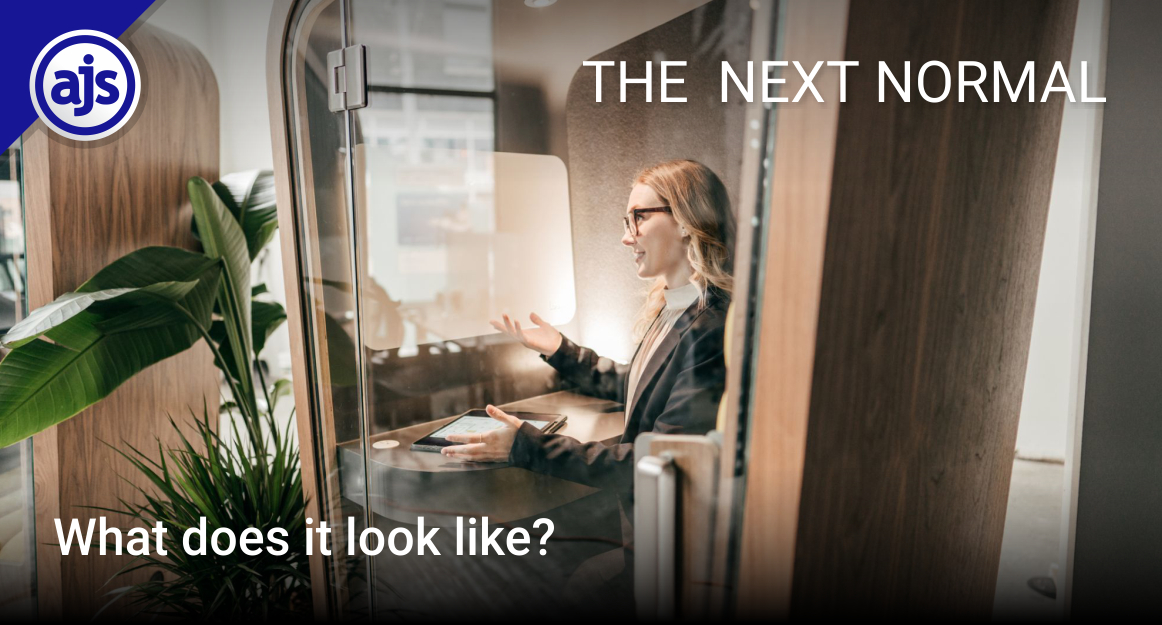
The Next Normal: Part III
What does it look like?
We can talk about The Next Normal until we are blue in the face – doing all we can to convince you that everything we have learnt (because of COVID) will aid in improving our work environment.
We can argue that remote working and investing in technology will be for the betterment of our work-life and home-life (creating a harmonious work-life balance). And we can advise our clients (and readers) that they should embrace the lessons learnt – even the “not-so-comfortable” ones, like working remotely and mental health awareness.
But, talking about the benefits without explaining what they will all look like, doesn’t do this Next Normal any justice because it’s kind of hard to picture. In isolation.
So, in this week’s article we thought we would describe what The Next Normal will look like.
Let’s start off with some statistics
Before we get into what the Next Normal entails, practically speaking, we thought we would set out some stats.
PwC undertook a survey (Global Hopes and Fears Survey 2022) of 52,195 workers in 44 countries and territories — one of the largest ever surveys of the global workforce. The following key findings are worth noting –
1. 1 in 5 workers say they are likely to switch to a new employer in the next 12 months (The Great Resignation remaining firmly on the radar of employees worldwide);
2. 35% of workers are planning to ask their employer for more money in the next 12 months;
3. 71% of workers cite an increase in pay is a main motivator for making a job change;
4. 69% of workers say they want a fulfilling job;
5. 66% of workers say they want to truly be themselves at work, and
6. Nearly half (47%) of survey respondents prioritised being able to choose where they work as a motivator for seeking alternative employment.
Similarly, EY undertook a survey of more than 16,000 employees across 16 countries and multiple industries and job roles. Key findings in their survey outlines the following –
1. 9 in 10 employees want flexibility in where and when they work;
2. 54% of those surveyed said that they would choose flexibility in when they work;
3. 40% of respondents want flexibility in where they work;
4. On average, employees would want to work between 2 -3 days remotely;
5. 48% of those surveyed said their organizational culture has changed and improved during the COVID-19 pandemic, while only 31% believe it has worsened, and
6. 64% of respondents said that they want better technology in the office (e.g. faster internet and videoconferencing).
The International Workplace Group has conducted research which shows that –
“the pandemic has had such an effect on employees’ priorities that they would forgo a 10% pay rise in favour of retaining the option to work remotely. 72% of office workers would prefer a hybrid way of working to a full-time return to the office – even if reverting to the old Monday-Friday routine meant earning more money.”
What do the stats mean, in monetary terms?
In 2019 (pre-COVID), according to Gallup, a trillion dollars was lost due to employee turnover –
“The cost of replacing an individual employee can range from one-half to two times the employee’s annual salary — and that’s a conservative estimate. So, a 100-person organization that provides an average salary of $50,000 could have turnover and replacement costs of $660,000 to $2.6 million per year.”
And again, that was pre-COVID. With staff turnover being at an all-time high, it is safe to say that the figure of a Trillion US Dollars would be significantly higher in 2022.
To illustrate this point, BuiltIn set out in their article The True Costs of Employee Turnover –
“it’s estimated that losing an employee can cost a company 1.5-2 times the employee’s salary. Depending on the individual’s level of seniority, the financial burden fluctuates. For hourly workers, it costs an average of $1,500 per employee. For technical positions, the cost jumps to 100-150 percent of salary. At the high end, C-suite turnover can cost 213 percent of salary.”
And if any conclusion can be drawn from the above it is this – retaining your employees is far more cost effective than replacing them. Considering the high rate of turnover, it is best to keep the needs and wants of employees in mind –
Ø flexibility (both in when and where the work);
Ø implementing (at least) a hybrid work model, and
Ø ensuring that employees are both fulfilled and able to be themselves at work (which therefore means that they feel supported).
How have employees changed the work landscape?
From the beginning of 2020 what has become quite clear is that employees learnt to improvise. They learnt to innovate and adapt during COVID lockdowns and as a result, fear of change dissipated (as paraphrased from the article Offices in 2022: Here’s What the ‘New Normal’ May Look Like).
What this means – employees have questioned (at some length) what they want out of their employment. They have taken a long, hard look at their own work-life balance and have realigned their priorities. Hoping that their employers would do the same.
In a way, employees have gained the upper hand. With the rate of staff turnover and the cost to company to replace employees being almost exorbitant – keeping employees happy is crucial.
The relationship employees have with the office has undoubtedly changed – where and how an employee works best has become key.
And the stats above support this.
Money is no longer the overall driver and employees are leaving their positions because the parameters of the position are not meeting their own personal requirements and priorities – workers need to “shape their job around their lifestyle. Hybrid working is no longer a ‘nice to have.” (International Workplace Group).
In addition to the above, Inc. Africa sets out that –
“We are all designers of our workday now, and the key to designing flexible work is separating what needs to be done together from individual work. Companies must dismantle their outdated routines and redesign them to prioritize flexibility, agility, and collaboration.”
So, what does the next normal look like?
The physical office?
Offices will need to change from a place where people have to be every day (due to outdated requirements), and instead evolve (according to hrfuture) into “corporate centres specifically meant to spur innovation and connection while developing team spirit.”
Essentially, the purpose of “offices” has changed.
The Next Normal will revolve around a work environment that is (according to Inc.Africa and hrfuture) –
Ø hybrid (working part-time at home and part-time at an office);
Ø agile (meaning fast moving and constantly adapting);
Ø interdependent (once separated disciplines merging), and
Ø decentralised (no longer one large head office).
The International Workplace Group in their white paper The Future of Work: A trends forecast for 2022 stated that –
“The office today is no longer a defined physical place. Rather, it is a digital construct. Often, data saved in the Cloud isn’t even in the same country as the staff accessing it.”
Employees can work at home, at a coffee shop, at the head office or at a smaller office in an alternative area using a hot desk. There no longer needs to be “a sea of desks in an expensive city centre location” (the Future of Work: a trends forecast for 2022). That would be pre-COVID thinking and as we can tell from the above stats, there is no going back to that.
Reconfiguring the office space will be key here. Flexibility and adaptability remaining at the heart of it all. Offices will be moved closer to where employees are based, resulting in “work happening in the heart of local communities everywhere – cities and suburbs, towns and villages” (The Future of Work: a trends forecast for 2022).
Offices can -as a result – also be downsized, resulting in a reduced spend in real estate and rental costs, along with tangible increased productivity from happy employees with the additional ability of being able to attract the best talent no matter where they are located – the barriers and boundaries to a “workplace” no longer exist. The result? A more distributed workforce, which also speaks to inclusivity and diversity.
The Next Normal calls for an “ecosystem of offices” in multiple locations, reinforcing “geographic diversity” (hrfuture) which will ensure that should any crisis arise in the future, there will be no (further) disruption to business operations.
Technology is key…
As Munich Re sets out –
“In-person interactions will always be at the heart of business, but the recent increase in adoption of technology has changed the perspective of working relationships forever. From hiring, training, and team meetings to closing deals and at-home services, technology will continue to evolve with innovative solutions to keep businesses flexible and thriving through the unexpected.”
The Next Normal will thus necessitate further investment in technology.
One of the ways this is being done (as set out by Microsoft in relation to Munich Re’s overhaul) is to have hybrid meetings in Teams Meeting Rooms, “bridging the gap between people working remotely and those in the office with a meeting room solution that allows everyone to be seen, heard, and fully participate from anywhere”.
For those of us that have become au fait with Zoom and Teams during the pandemic this just supersizes the technology already being used but on a larger scale enabling the involvement of team members no matter where they are. Physicality – once again – is no longer an issue and collaboration across teams and jurisdictions will thus be at the forefront of the Next Normal.
Practically, and according to office reality, this could also result in office furniture supporting this type of cross jurisdictional collaboration –
“ Acoustic Pods and booths with monitors are a great way to ensure that managers and employees can stay connected when working remotely. Additionally, traditional meeting rooms may be revamped into ‘Zoom Rooms’ with acoustic panels and ceiling baffles to improve the acoustics whilst on a call. Furniture to feature and support technology, such as inbuilt phone chargers, USB, and HDMI sockets.”
In addition, and especially with a flexible hybrid work model, office furniture will need to be fully customisable so that it can be moved around and stowed away according to requirements – opening up and importantly, freeing up space.
Local South African companies such as Wood Creations, can custom make furniture for any size office that embraces a flexible outlook (especially with their fully customisable solutions).
The biggest impact on the practical office side of things is not only going to be the downsizing of offices to suit a diverse and flexible work environment, but also the ingenuity and investment in forward thinking technology to support an office structure that is truly forward thinking. An office structure that is adaptable and transformative – an office space that will remain relevant and “current” for years to come.
We believe that this is just the beginning of something truly era-defining. How we all embrace the flexibility and adaptability of the Next Normal could have a tremendous impact on the future work force. Hopefully, we change things so that the future work force can lead more enriched (and less stressed) lives.
To embrace The Next Normal get in touch with AJS to find out how we can support you and assist you with incorporating legal technology into your practice. Taking you into The Great Beyond.
– Written by Alicia Koch on behalf of AJS





Leave a Reply